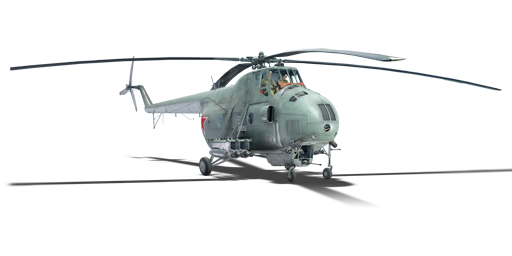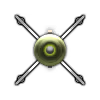


The Mi-4 was designed as a response to the American H-19 Chickasaw and its effective deployment in the Korean War. Design and testing commenced in the early 1950s before being rushed into service in 1953. The helicopter was used in both civil and military roles, and earned a good reputation for its reliability and high payload capacity, and continued to be used around the world until the 2000s.
Experiments on arming the Mi-4 were carried out in the 1960s, but the first serial attack modification of the helicopter, designated Mi-4AV (Mi-4A Vooruzhennyy; "Armed"), appeared only in 1966. A weapon system from the Mi-24A still under development was installed on the helicopter for testing, enabling up to four 9M17M Falanga ATGMs and six S-5 rocket pods or bombs, and a 12.7 mm A-12.7 machine gun was installed in the ventral gondola. In the USSR, around 200 helicopters were converted to the Mi-4AV variant.
The Mi-4AV (NATO reporting name: Hound), was introduced in Update 1.81 "The Valkyries". The Mi-4AV is the starter helicopter for the Soviet tech tree, and at first seems very underwhelming, but once familiarized can be one of the best starter helicopters in the game. The Mi-4AV has access to the Falanga ATGM with 4 km of range which in the right scenarios can be very deadly to enemy tanks. Pilots of the Mi-4 must be very careful of the aircraft's underpowered engine and abysmal flight performance: due to being a piston-powered helicopter, the engine is somewhat inadequate at full combat loads, and the helicopter will feel even more sluggish than it already is. This makes the Mi-4AV a very easy target for most radar-guided SPAA at range, due to its inability to dodge incoming fire very easily. However, the 4 Falangas it carries can also engage enemy SPAAs at ranges further than any other helicopter at its Battle Rating, and can cause devastating damage if left uninterrupted. All in all, the helicopter lacks the agility of other, lighter helicopters found in other trees but boasts a high number of guided anti-tank missiles that have the furthest range of any ATGM on a starter helicopter and can deliver lethal long range fires if given the opportunity.
| Belt | Belt filling | Armor penetration (mm) at a distance: | |||||
|---|---|---|---|---|---|---|---|
| 10 m | 100 m | 500 m | 1000 m | 1500 m | 2000 m | ||
| AP-I/API-T/AP-I | 29 | 27 | 20 | 13 | 9 | 6 | |
| AP-I/AP-I/IAI/API-T | 29 | 27 | 20 | 13 | 9 | 6 | |
| IAI/AP/API-T/AP | 31 | 30 | 22 | 16 | 11 | 8 | |
| IAI/API-T/IAI/IAI | 29 | 27 | 20 | 13 | 9 | 6 | |
| Name | Weight | Slot | ||||||||||
|---|---|---|---|---|---|---|---|---|---|---|---|---|
| 31.5 kg |  |  |  |  | ||||||||
| 16 × | 110.2 kg |  |  |  |  |  |  | |||||
| 103.5 kg |  |  |  |  |  |  | ||||||
| 252.2 kg |  |  |  |  | ||||||||












Flight performance |
|---|
Survivability |
|---|
Weaponry | ||
|---|---|---|